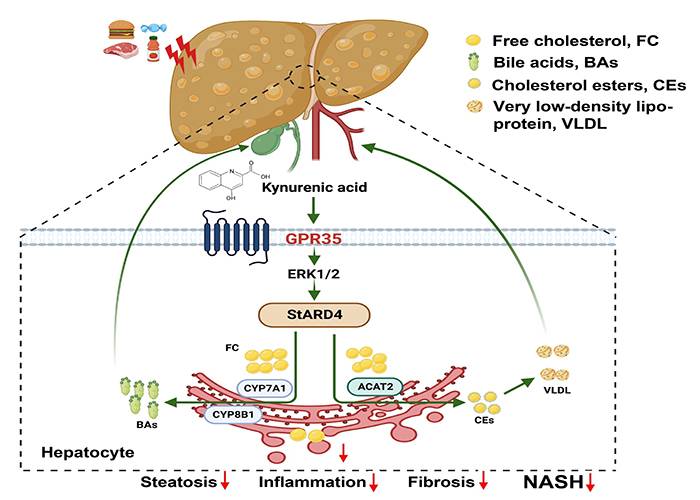Recently, Acta Pharmaceutica Sinica B (IF=14.9), a top journal in the field of pharmaceutical sciences, published the latest findings of the research team of Prof. Wang Xuefu and Prof. Wanghua. Their publication was entitled “G protein-coupled receptor 35 attenuates nonalcoholic steatohepatitis by reprogramming cholesterol homeostasis in hepatocytes”. Doctoral student Wei Xiaoli, postgraduate students Yin Fan and Wu Miaomiao were credited as the co-first authors, and Prof. Wang Xuefu and Prof. Wanghua worked as the corresponding authors, with The First Affiliated Hospital of AHMU as the first authors’ affiliation.
The global prevalence rate of nonalcoholic fatty liver disease (NAFLD) is about 25%, and shows an upward tendency. NAFLD is a series of liver diseases ranging from asymptomatic steatosis (nonalcoholic fatty liver, NAFL), nonalcoholic steatohepatitis (NASH), to cirrhosis and hepatocellular carcinoma. NASH is a key stage in the clinical progress of NAFLD. And it has become an important field of liver disease prevention and treatment. But at present, there is a lack of effective therapeutic drugs and key targets.

The study found that G protein-coupled receptor 35 (GPR35) played an important role in high-fat/ cholesterol/ fructose (HFCF) diet-induced NASH. GPR35 overexpression in hepatocytes protected against HFCF diet-induced liver steatosis, inflammation, and fibrosis, whereas loss of GPR35 had the opposite effect. Administration of the GPR35 agonist kynurenic acid (Kyna) suppressed HFCF diet-induced steatohepatitis in mice. Kyna/GPR35 induced expression of StAR-related lipid transfer protein 4 (STARD4) through the ERK1/2 signaling pathway, ultimately resulting in hepatic cholesterol esterification and bile acid synthesis (BAS). The overexpression of STARD4 increased the expression of the BAS rate-limiting enzymes cytochrome P450 family 7 subfamily A member 1 (CYP7A1) and the cholesterol lipoprotein acyl-coenzyme A: cholesterol acyltransferase 2 (ACAT2), promoting the conversion of cholesterol to bile acid and cholesterol esterification. STARD4 overexpression in hepatocytes reversed the aggravation of HFCF diet-induced steatohepatitis due to the loss of GPR35 expression in hepatocytes. So GPR35 expression in hepatocytes is a key regulator of cholesterol homeostasis in NASH.
The research team found that Kyna/GPR35 can also improve the inflammatory reactions and metabolic disorders induced by high-fat diet by ameliorating NLRP3 inflammasome activation in macrophages. The findings were published in the research paper titled “Kynurenic acid ameliorates NLRP3 inflammasome activation by blocking calcium mobility via GPR35” in Frontiers in Immunology (IF=8.786).
Targeting GPR35 expression in hepatocytes may be a promising approach for NASH treatment. This series of studies provides new ideas and targets for the treatment of NASH. The work was supported by the National Natural Science Foundation of China and the Natural Science Foundation of Anhui Province.
Source: https://www.sciencedirect.com/science/article/pii/S221138352200436
